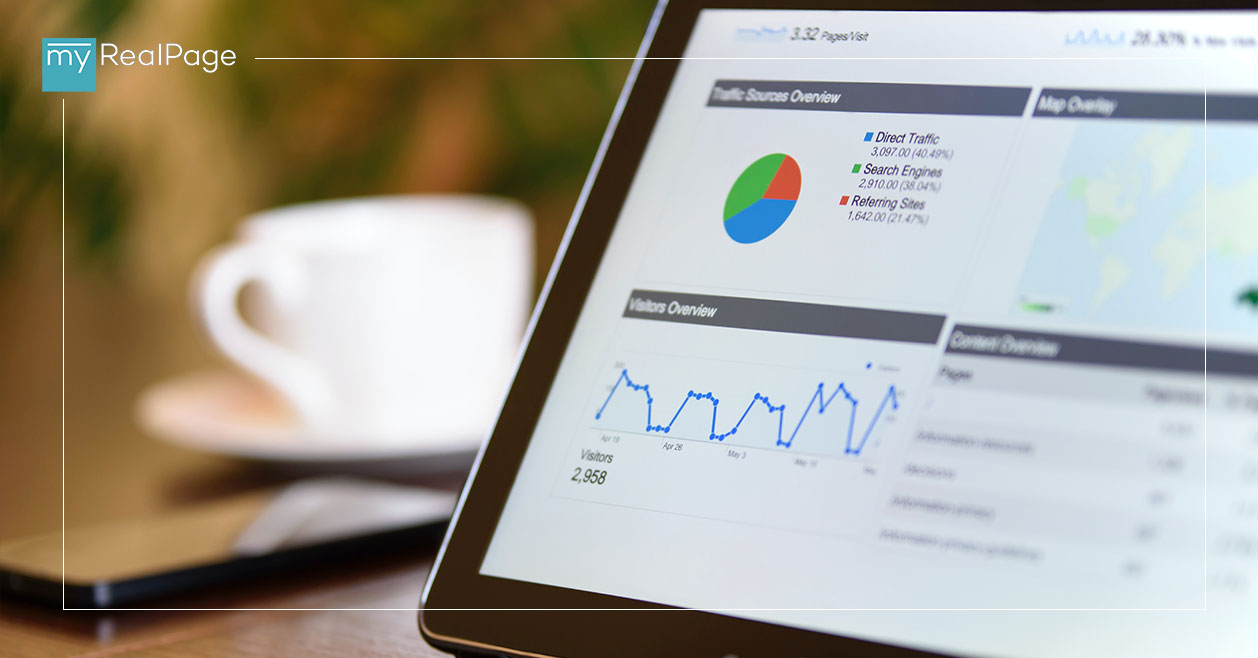Google Analytics for Real Estate Agents: 6 Key Metrics You Should Pay Attention to

We talk a lot on this blog about the importance of your real estate agent website.
It’s the first impression you give potential leads. It’s where you sell yourself. It’s where you show off your listings.
It’s how you convince people that they should strongly consider hiring you as their real estate estate agent.
But your website can only achieve any of the above feats if it’s performing well.
And how do you know if your website is performing well?
Google Analytics — the most powerful tool for analyzing and evaluating performance data about your website.
The robustness of Google Analytics means it has a ton of great info to offer. But all that info can be overwhelming, especially if you’re not a super experienced user (and most real estate agents aren’t).
To get the most out of Google Analytics, you need to know what information to focus on.
For real estate agents, some metrics matter more than others. Like the ones below — the six Google Analytics metrics that real estate agents should pay attention to.
Heads up: this post refers to metrics and definitions found in Google Analytics 4 (GA4), the newest iteration of Google’s analytics platform.
User Metrics
“Users” refers to website visitors.
In Google Analytics 4, users are the number of visitors that have been active within a period of 28 days. You can also look specifically at the number of users who visited your site for the very first time (new users), as well as the total number of visitors over a certain time frame (which would include repeat users).
The Users metric is one of the simplest that Google Analytics offers, but it’s one of the most fundamental.
You can use it to get a sense of how many people are coming to your website, how many of those people are coming for the first time or have visited before, and whether visits have increased or decreased over a certain amount of time — which you might be able to connect to an activity, such as a real estate newsletter you sent out or a new listing shared on Instagram.
Sessions
A session is technically a visit to your website, and all the ways a visitor interacts with your website during that visit. A session ends by default after a visitor has been inactive for 30 minutes, or has left your website. If the visitor comes back later that day, that’s another session. You might have 100 visitors in a week but 200 sessions if some visitors returned later in the day or later in the week.
It’s key to understand Sessions, as they’re often referenced in other Google Analytics — like the metrics below.
Plus, looking at your Sessions data in conjunction with other metrics, such as Users, Events and Engaged Sessions, can help paint a more detailed picture of how your website is performing.
User Engagement Metrics
It’s encouraging to see your website receiving a growing number of visitors. But the real magic happens when you know those visitors are interacting with your website — not just opening the page and quickly exiting. This is called engagement.
Google Analytics offers several engagement metrics that analyze just how engaged visitors are with your website. These metrics include:
- User Engagement: This measures the time when your web page was in focus on a visitor’s browser, meaning when they were actively viewing or using your website.
- Engaged Sessions: The number of Sessions that lasted for at least 10 seconds, or a Session where a visitor saw at least two pages, or completed at least one conversion (an important action a visitor can take that you’ve set up to be tracked in Google Analytics, such as filling out a form, clicking a link, or watching a video).
- Bounce Rate: The percentage of sessions that do not qualify as engaged sessions.
- Engagement Rate: The percentage of sessions that were engaged.
- Engaged Sessions Per User: The average number of engaged sessions per user.
Events
Events are essentially interactions with your website. Events that can be tracked in Google Analytic include:
- Page view: Each time a user loads a web page.
- Scroll: When a user scrolls to the bottom of a page.
- Video start; Video complete: When a video starts playing and when a video is completed.
- Search results: Each time a visitor searches your site.
You can also create custom Events to track.
Events metrics provide the clearest idea of what users are doing — and not doing — on your website. And that in turn can give you a clear idea of where your website is strongest, and where it might need some work.
Are visitors only watching a specific embedded real estate video 20% of the way through? That video might be too long, not engaging enough, or not helpful.
Are they reaching the bottom of some pages, but not others? What could the latter be doing differently?
What pages are getting the most action? What pages are getting the least?
Traffic Acquisition
You probably have several different strategies to get people to visit your real estate website.
Facebook Ads. Instagram Stories. Newsletters. Postcard campaigns. SEO efforts so your website will appear high in search results. Even your email signature can encourage a visit.
The only way to know if those strategies are working is to analyze how visitors are arriving at your site.
Enter Traffic Acquisition in Google Analytics.
The Traffic Acquisition report (a report is a section that tracks multiple related metrics in one place) is where you can learn exactly how visitors make their way to your website.
For instance, you can see how many visitors…
- Arrived by using a search engine and clicking your link in the results
- Got there by clicking your Facebook ad
- Typed your URL directly into their browser
- Clicked a link in your newsletter
Paying attention to your sources of traffic can give you a clear sense of which efforts are working and which efforts need some work.
Exits
In addition to telling you how visitors got to your site, Google Analytics can tell you where they entered. That’s called an Entrance.
Google Analytics can also tell you where a visitor left from. That’s called an Exit, and it’s a pretty interesting metric to pay attention to.
Sometimes, the page that a visitor is on when they decide to leave the website doesn’t reveal a greater meaning. Maybe they just happened to be reading your About Me page when they got a call and closed the browser tab.
Sometimes, though, Exits do have greater meaning. If you start to see that a not-so-insignificant number of visitors are all leaving your site from, let’s say, your Blog page, it’s probably safe to assume that the content on your real estate blog isn’t compelling enough to keep them there.
When examined alongside the other metrics mentioned in this post, Exits can provide fascinating insights that you can use to improve your real estate website.
What else do you want to know about Google Analytics for real estate websites?
Last Updated on May 5, 2025 by myRealPage


